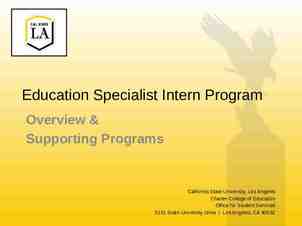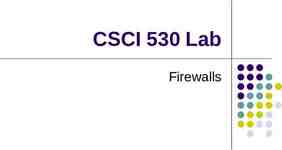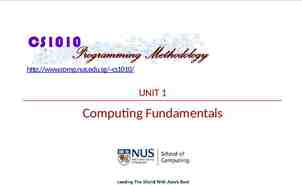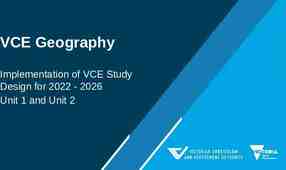NSW Department of Education Early Stage 1 One unit of work – sample
38 Slides6.39 MB
NSW Department of Education Early Stage 1 One unit of work – sample A All K-6 key learning areas
NSW Department of Education How to use this resource Each key learning area has sequential activities linked to outcomes. Choose the activities you wish to use and cut and paste them into your weekly class timetable with the resource links. Where necessary, access the sample worksheet templates provided with the task. English This resource includes 5 sequential tasks, with outcomes, from various English objectives. Each task has a duration between 45 minutes and 1 hour. Links to the online resources have been included with the tasks. Science and technology HSIE Mathematics This resource includes 5 sequential tasks, with outcomes, from a mathematics strand and sub strand. Each task has a duration between 45 minutes and 1 hour. Links to the online resources have been included with the tasks. PDHPE Creative arts This resource includes 3 sequential tasks, with outcomes, for each key learning area. Each task has a duration between 30 minutes and 1 hour. Links to the online resources have been included with the tasks. Stage ES1 Week A
NSW Department of Education Support for assessment and feedback Advice and resources The department’s Curriculum planning and programming, assessing and reporting to parents K-12 policy informs school-based decisions about assessment and reporting processes. A collection of ready-to-use assessment tasks, assessment activity templates and tools have been developed to support assessment and feedback. These resources could be used in both face-to-face and online classroom settings. Professional learning The strategies for assessment and feedback for K-6 professional learning provides a guide for K-6 teachers about how to assess and provide feedback online to students. It also provides advice to support parents and carers of K-6 students with assessment and feedback. Access the MyPL link to this professional learning under the primary curriculum section of the website.
NSW Department of Education English – overview of tasks Objectives A 1. Speaking and listening – What’s cooking in the kitchen? 2. Reading and viewing – ‘Big Rain Coming’ 3. Writing and representing – Waiting is hard! 4. Handwriting – the letter I i 5. Spelling – Beginning and ending sounds, plurals (worksheet sample provided) Stage ES1 Week A
NSW Department of Education English task 1 – 45 minutes Objective A Speaking and listening 1 – ENe-1A – What’s cooking in the kitchen? What do to: look in the kitchen and without gesturing or hand signals, describe one object in detail to an adult try not to name the object. You are encouraged to use descriptive language. For example, the oven is shiny, metal, black and large draw the kitchen objects just like you described them ask an adult to help you label all the kitchen objects. Stage ES1 Week A
NSW Department of Education English task 2 - 45 minutes Objective A Reading and viewing 1 – ENe-4A – ‘Big Rain Coming’ What to do: watch the shared reading video – listening, Big Rain Coming by Katrina Germein and illustrated by Bronwyn Bancroft discuss the character of Old Stephen. What does he look like? What is his personality? Is he happy, sad, calm? talk to an adult about what you liked about this story. Look at the patterns in the illustrations draw Old Stephen and make bright patterns behind him like in the book. He could be standing in a field, out in the rain or in front of a forest of trees. Stage ES1 Week A
NSW Department of Education English task 3 – 45 minutes Objective A Writing and representing 1 – ENe-2A – ‘Waiting is hard!’ What to do: waiting for something can be hard! Sometimes waiting can be exciting, sometimes it fills you with fear discuss waiting for something, or someone, like Christmas, a tooth to fall out or even waiting for a new brother or sister! draw a picture, showing what you have had to wait a long time for. Add labels to your drawing or a few sentences to explain your picture discuss this with an adult and record your answer. Stage ES1 Week A
NSW Department of Education English task 4 – 45 minutes Objective A Handwriting – ENe-3A – ‘The letter I I’ What to do: after watching video lesson 1, practise writing the letter i, both lowercase and uppercase make sure you are sitting correctly with your feet on the floor hold your pencil so it rests easy in the soft spot between your thumb and your pointer finger is your pencil sharp? You’re ready to start writing! after you have finished the activities from the video lesson 1, think of as many words that you can that start with the letter i. Write them down using a new colour for each letter in the word, for example iguana ask an adult for some help with the words that are a bit trickier. Stage ES1 Week A
NSW Department of Education English task 5 – 45 minutes Objective A Spelling – ENe-5A – Beginning and ending sounds and plurals What to do: look at the words in the list and sound them out (see next slide) in the first column, change the letter at the beginning of the word to make a new word (see next slide) in the second column, change the letter at the end of the word to make a new word (see next slide) a plural makes a word mean more than one. For example, to make the word ‘ant’ plural, we need to add ‘s’ to the end to make ‘ants’ make the words in the third column plurals by writing them and adding a ‘s’ to the end. (see next slide) Stage ES1 Week A
NSW Department of Education English task 5 continued Change the first letter in these words to make a new word Change the last letter in these words to make a new word Make these words plural (more than 1) by adding ‘s’ to the end 1. cat 1. sap 1. cow 2. pan 2. dam 2. table 3. sand 3. lip 3. peg 4. lot 4. jot 4. spoon 5. fit 5. his 5. pen 6. lap 6. rig 6. hand 7. dog 7. from 7. book 8. mop 8. lop 8. can 9. jump 9. fan 9. ball 10.peg 10.but 10. tree Stage ES1 Week A
NSW Department of Education Mathematics – overview of tasks 1. Measurement and geometry – ‘About how many rectangles?’ 2. Number and algebra – ‘Go Fish’ (relationships) and ‘Race to write’ 3. Measurement and geometry – ‘Stampolines follow up’ 4. Measurement and geometry – ‘MathXplosion: 7 feet follow up’ 5. Number and algebra – ‘Subitising dice patterns 1-4, match my collection’ Stage ES1 Week A
NSW Department of Education Mathematics task 1 – 45 minutes Measurement and geometry – Two-dimensional space – MAe-15MG – ‘About how many rectangles?’ Working mathematically outcomes: MAe-1WM, MAe-2WM, MAe-3WM What to do: view video on ‘Math imagination warm up 1 - about how many rectangles?’ about how many of the smaller orange rectangles are needed to fill the area of the large dark blue rectangle? draw a picture to share your thinking. View video – ‘About how many rectangles (part 2)’ Discuss with someone at home what you discovered about how many orange rectangles are needed to cover the larger blue rectangle. Did you notice similar things? Stage ES1 Week A
NSW Department of Education Mathematics task 2 - 45 minutes Number and algebra – Whole numbers – MAe-4NA, MAe-5NA – ‘Go Fish’ (relationships) Working mathematically outcomes: MAe-1WM, MAe-2WM, MAe -3WM What to do: view video – ‘Go Fish: Relationships’ and have some playing cards ready play ‘Go Fish: Relationships’ with someone at home have fun trying some of the other game versions suggested in the video. Optional second activity: Race to write visit the ‘Race to write’ page and play the game with someone at home. Stage ES1 Week A
NSW Department of Education Mathematics task 3 – 45 minutes Measurement and geometry – Two-dimensional space – MAe-15MG – ‘Numberblocks Stampolines follow up’ Number and algebra – Addition and subtraction – MAe-5NA – ‘Stampolines follow up’ Working mathematically outcomes: MAe-1WM, MAe-2WM, MAe -3WM What to do: view episode of ‘Numberblocks – Stampolines’ and the Numberblocks - Stampolines follow up video what are all the different shapes Six could make playing Stampolines? come up with at least 5 different (and new) ways and draw them in your workbook. Stage ES1 Week A
NSW Department of Education Mathematics task 4 – 45 minutes Measurement and geometry – Length 1 – MAe-9MG – ‘MathXplosion: 7 feet follow up’ Working mathematically outcomes: MAe-1WM, MAe-2WM, MAe-3WM What to do: watch this episode of MathXplosion view video on MathXplosion: 7 feet follow-up and have a go at making your own foot as a unit of measurement Are you 7 feet tall? can you find some things that are more than your 7 feet tall? Write and draw your findings in your workbook can you find somethings less than your 7 feet tall? Write and draw your findings. Stage ES1 Week A
NSW Department of Education Mathematics task 5 – 45 minutes Number and algebra – Whole numbers – MAe-4NA – ‘Dice patterns and subitising’ Working mathematically outcomes: MAe-1WM, MAe-2WM, MAe-3WM What to do: view video on Dice Patterns A (1-4) page. Be ready to watch, listen, imagine, draw and write view video on ‘Subitising - match my collection’ page. Have your collection of 10 things, like dried pasta or blocks, ready. Stage ES1 Week A
NSW Department of Education Science and technology – overview of tasks Living world 1. ‘Is it alive?’ (worksheet sample provided) 2. ‘My two favourite living things’ 3. ‘I’m hungry!’ (worksheet sample provided) Stage ES1 Week A
NSW Department of Education Science and technology task 1 – 1 hour Living world – STe-3LW-ST – ‘Is it alive?’ Focus question – What do you notice about living things? What to do: look at the pictures in the table (see next slide) think about what you know about living things. Put a tick if you think it is living or a cross if you think it is not living talk to your parent or carer about why you think it is living trace the words in the last column. Can you read some of the words? go to your backyard or for a walk to the local park with your parent or carer. What living things can you see? Do you know what they are? How do you know it is living? Talk to your parent or carer about what living things you see. Take a picture or draw them. Stage ES1 Week A
NSW Department of Education Science and technology task 1 continued Is it a living thing? Tick/ cross What is it? dog butterfly bag snake crayons snail road Stage ES1 Week A
NSW Department of Education Science and technology task 2 – 45 minutes Living world – STe-3LW-ST – ‘My two favourite living things’ Focus question – What do you notice about living things? What to do: choose two living things. Draw a picture of each one in a box add three labels to each of the pictures to show details write a sentence or talk to your parent/carer about why you think they are living things. (What can they do?) Stage ES1 Week A
NSW Department of Education Science and technology task 3 – 45 minutes Living world – STe-3DP-ST – ‘I’m hungry!’ Focus question – Can living things be used to meet our needs? What to do: Aboriginal Australians sometimes find their food in the bush. Bush tucker is food from plants and animals that are from the Australian outback. Some plants can be poisonous and make you very sick. Never eat from any plants found in parks or your backyard here are some pictures of bush tucker (see next slide) draw foods that you eat that might be similar to bush tucker. You may need help from your parent or carer to read the sentences below the pictures make a list of what is needed to keep these bush tucker foods alive and healthy while they are growing. Stage ES1 Week A
NSW Department of Education Science and Technology Task 3 continued Bush food My food This is a bush tomato This is a woody pear These are bush cherries ‘Bush tomato’ photo by Mark Marathon under Creative Commons Attribution-Share Alike 3.0 Unported from Wikimedia ‘Woody pear’ photo by Poyt448 Peter Woodard under Creative Commons Attribution-Share Alike 3.0 Unported from Wikimedia ‘Bush cherries’ photo from pixabay.com Stage ES1 Week A
NSW Department of Education HSIE geography – overview of tasks People live in places 1. ‘My place’ 2. ‘What makes a place special to people?’ 3. ‘Making maps’ Stage ES1 Week A
NSW Department of Education HSIE geography task 1 – 45 minutes People live in places – GEe-1, GEe-2 – ‘My place’ Key inquiry question – What are places like? What to do: look out a window or walk to a park with an adult. Draw a picture of what you see add labels to the picture you drew. The labels describe the features in your drawing. For example, tree, path, play equipment, garden, grass, street, car, shed add a title to the picture. The title tells other people what this picture is about. For example, here is a labelled picture of a backyard you have just made a map! Stage ES1 Week A
NSW Department of Education HSIE geography task 2 – 45 minutes People live in places – GEe-1, GEe-2 – ‘Favourite places’ Key inquiry question – What makes a place special? What to do: think about the place you have drawn describe to an adult 2 ways you use that place. For example, play with toys describe two ways you look after that place (tell an adult). For example, tidy up toys, put the bike away, clean up leaves or rubbish places are special to people for lots of different reasons. What is your favourite place? Is it a room in your house or somewhere you like to visit? What do you like most about your favourite place? Draw your favourite place and label it with the things around it ask different family members what their favourite place is. It could be a favourite room in the house or their favourite place to visit. Ask them to tell you why it is their favourite place. What do they like most about it? Can they show you a photo of their favourite place? Stage ES1 Week A
NSW Department of Education HSIE geography task 3 – 45 minutes People live in places – GEe-1, GEe-2 – ‘Making maps’ Key inquiry question – How can we represent places? What to do: imagine you are walking around your home, garden or a park. Think about what you might see (tell an adult). This view of places is called a street view or eye-level view of a place. You drew an eye-level picture in task 1 imagine you are a bird, or you are in a helicopter, flying over your home or local park. Think about what you might see as you look at the ground (tell an adult). You might see different shapes, for example, houses might look like rectangles or squares and trees might look like flat circles. This view of places is called a bird's-eye view, or aerial view, of a place. You could ask someone to use Google Earth to show you a place from a bird's-eye view use a bird's-eye view to draw a map of the rooms in your house or your backyard or the park. Remember to give your map a title and label the important features on your map. (To see the rooms in your house, imagine there is no roof. The rooms in your house might look like squares) Stage ES1 Week A
NSW Department of Education PDHPE – overview of tasks Health, wellbeing and relationships 1. Feelings and emotions (worksheet sample provided) 2. What am I good at? (worksheet sample provided) Movement skill and performance 3. Let’s get moving (worksheet sample provided) Stage ES1 Week A
NSW Department of Education PDHPE task 1 – 45 minutes Health, wellbeing and relationships – PDe-3, PDe-9 – ‘Feelings and emotions’ Key inquiry question – How can we care for and include each other? What to do: during this activity you will identify and explore your emotions discuss with your teacher or parent/carer the following question “what are emotions?” identify the different emotions in the table (see next slide) draw a line to match the emotion picture with the word write one thing for each emotion that makes you feel that way on the next table, draw one of the faces (emotions) that shows how you feel about each situation (see next slide) explain to a teacher or parent/carer why you chose this emotion. Stage ES1 Week A
NSW Department of Education PDHPE task 1 – part 1 Image Emotions One thing that makes you feel scared happy excited worried proud angry sad Images used from NSW Department of Education Child Protection Education resources Stage ES1 Week A
NSW Department of Education PDHPE task 1 – part 2 How do you feel about being at school? playing with your friends? your home? your family? Stage ES1 Week A Draw and explain the emotion that is most appropriate
NSW Department of Education PDHPE task 2 – 45 minutes Health, wellbeing and relationships– PDe-3, PDe-9 – ‘What am I good at?’ Key inquiry question – What makes me unique? What to do: discuss the following questions with your teacher or parent/carer: o What are some things you are good at? o Which ones do you enjoy? o Why do you enjoy them? using the T-chart (see next slide) draw pictures about what you know you are good at, and draw some pictures about what you think you might be good at. Stage ES1 Week A
NSW Department of Education PDHPE task 2 continued What I am good at. What I might be good at. Draw a picture and tell an adult why you are good at this. Draw a picture and tell an adult why you think you might be good at this. Stage ES1 Week A
NSW Department of Education PDHPE task 3 – 45 minutes Movement skill and performance – PDe-4 – ‘Let's get moving’ Key inquiry question – How do we move our bodies? What to do: create a target where you can safely throw a soft object towards select a ‘starting point’ where you will throw the object from throw the object towards the target. You should aim to hit the target pick up the object from where it landed and throw the object again until the target has been hit record how many throws it took to hit the target using Table 1 ‘Throwing for accuracy’ (see the next slide) repeat the challenge several times attempting to hit the target in a fewer number of throws. Stage ES1 Week A
NSW Department of Education PDHPE Task 3 – continued Throwing accuracy How many throws did you take to hit the target? Stage ES1 Week A Attempt 1 Attempt 2 Attempt 3 Attempt 4 Attempt 5
NSW Department of Education Creative arts – overview of tasks Visual arts – Connotation, imagery and symbol 1. ‘Symbols around us’ 2. ‘Pop art 1’ – Howard Arkey 3. ‘Pop art 2’ – Andy Warhol Stage ES1 Week A
NSW Department of Education Creative arts task 1 – 45 minutes Visual Arts – VAES1-1, VAES-2 – ‘Symbols around us’ What to do: watch this video : ‘Process of a form of symbolic abstract painting' go outside to a special place within your school or local environment. Where possible take a plastic surface, some cardboard, a paver or alternatively find some concrete or into a tiled or paved area. Take some water in a container and a paintbrush look around at the environment in silence. Find something important or interesting about the environment – either natural or man-made create a quick symbol of something in this environment that is important to you. Once it has vanished, repeat with another symbol. Here is an example to look at. It is a symbol (umbrella) of a wet area. Stage ES1 Week A
NSW Department of Education Creative arts task 2 – 1 hour Visual arts – VAES1-1, VAES1-3, VAES1-4 – ‘Pop art 1’ What to do: look at a different image of the Australian landscape ‘Triple fronted’ by Howard Arkley from the Art Gallery of NSW it is about suburban city streets and houses in Australia. He loved decorating magazines and advertising. How does it look similar to most streets, but how does it look different? Arkley’s style is called ‘pop art’ because he takes something ordinary like this house and changes it with bright colours draw your home using a pencil on the next blank page. trace over your drawing with a black pencil or markers transform your drawing using different colours, not the colours that you can see, to make it a pop art style. You might choose to use markers, crayons or paints to give this bright effect tell someone about why you chose the colours you did. Stage ES1 Week A
NSW Department of Education Creative arts task 3 – 1 hour Visual Arts – VAES1-1, VAES1-3, VAES1-4 – ‘Pop art 2’ Connotation, imagery and symbol in visual arts What to do: look at the artwork ‘Campbell’s Soup Cans’ by Andy Warhol. This is another example of pop art – a bit like ‘Triple fronted’ by Howard Arkley. Think about how they are similar and how they are different? looking at ‘Campbell’s Soup Cans’, are the cans all the same? how are they different? Andy Warhol made this artwork because he ate a type of Campbell’s soup every day for lunch. He wanted to show the cans looking like a supermarket shelf but also to show that although they are the same – they are also different what items do you notice or look at in rows in the supermarket? Draw your answer. Stage ES1 Week A











































